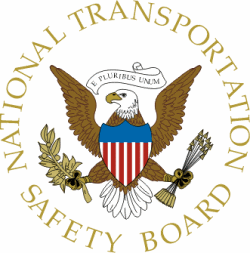Sat, Jul 09, 2011
Follows Probable Cause Report From A Fatal Accident Involving A
Police Helicopter
 While the NTSB's probable cause report from an accident in 2009
cited a New Mexico State Police pilot's decision making as the
primary cause for an accident which fatally injured two and
seriously hurt one, the board also had some harsh words for the
culture of the police department which it says stressed mission
execution over safety. As a result, the board on Thursday issued a
series of recommendations to several organizations in an effort to
prevent a repeat of the accident.
While the NTSB's probable cause report from an accident in 2009
cited a New Mexico State Police pilot's decision making as the
primary cause for an accident which fatally injured two and
seriously hurt one, the board also had some harsh words for the
culture of the police department which it says stressed mission
execution over safety. As a result, the board on Thursday issued a
series of recommendations to several organizations in an effort to
prevent a repeat of the accident.
The board's recommendations to the International Association of
Chiefs of Police and the National Association of State Aviation
Officials include encouraging members to conduct an
independent review and evaluation of their policies and procedures
and make changes as needed to align those policies and procedures
with safety standards, procedures, and guidelines, such as those
outlined in Airborne Law Enforcement Association guidance. Further,
the board recommends that the association's members be encouraged
to develop and implement risk assessment and management procedures
specific to their operations, install 406-megahertz emergency
locator transmitters on all of their aircraft, and install
flight-tracking equipment on all public aircraft that would allow
for near-continuous
flight tracking during missions.
Recommendations sent to the Airborne Law Enforcement Association
include a revision of standards to define pilot rest and ensure
that pilots receive protected rest periods that are sufficient to
minimize the likelihood of pilot fatigue during aviation
operations, as well as accreditation standards to require that all
pilots receive training in methods for safely exiting inadvertently
encountered instrument meteorological conditions for all aircraft
categories in which they operate. The board said the ALEA should
also encourage its members to install 406-megahertz emergency
locator transmitters on all of their aircraft, and install
flight-tracking equipment on all public aircraft that would allow
for near-continuous flight tracking during missions.

NM Governor Martinez
The board also made three recommendations to the governor of the
state of New Mexico. It said the New Mexico Department of Public
Safety should be required to bring its aviation section policies
and operations into conformance with industry standards, such as
those established by the Airborne Law Enforcement Association, and
to develop and implement a comprehensive fatigue management program
for the New Mexico State Police (NMSP) aviation section pilots
that, at a minimum, requires NMSP to provide its pilots with
protected rest periods and defines pilot rest (in a manner
consistent with 14 Code of Federal Regulations 91.1057) and ensures
adequate pilot staffing levels and aircraft hours of availability
consistent with the pilot rest requirements. The board further said
that New Mexico State Police (NMSP) search and rescue (SAR)
policies should be revised or reinforced to ensure direct
communication between NMSP aviation units and SAR ground teams and
field personnel during a SAR mission.
More News
Aero Linx: International Federation of Airworthiness (IFA) We aim to be the most internationally respected independent authority on the subject of Airworthiness. IFA uniquely combi>[...]
Ultrahigh Frequency (UHF) The frequency band between 300 and 3,000 MHz. The bank of radio frequencies used for military air/ground voice communications. In some instances this may >[...]
A Few Questions AND Answers To Help You Get MORE Out of ANN! 1) I forgot my password. How do I find it? 1) Easy... click here and give us your e-mail address--we'll send it to you >[...]
From 2019 (YouTube Edition): Learning To Paint Without Getting Any On Your Hands PPG's Aerospace Coatings Academy is a tool designed to teach everything one needs to know about all>[...]
Also: Sustainable Aircraft Test Put Aside, More Falcon 9 Ops, Wyoming ANG Rescue, Oreo Cookie Into Orbit Joby Aviation has reason to celebrate, recently completing its first full t>[...]
 ANN's Daily Aero-Linx (05.06.25)
ANN's Daily Aero-Linx (05.06.25) ANN's Daily Aero-Term (05.06.25): Ultrahigh Frequency (UHF)
ANN's Daily Aero-Term (05.06.25): Ultrahigh Frequency (UHF) ANN FAQ: Q&A 101
ANN FAQ: Q&A 101 Classic Aero-TV: Virtual Reality Painting--PPG Leverages Technology for Training
Classic Aero-TV: Virtual Reality Painting--PPG Leverages Technology for Training Airborne 05.02.25: Joby Crewed Milestone, Diamond Club, Canadian Pilot Insurance
Airborne 05.02.25: Joby Crewed Milestone, Diamond Club, Canadian Pilot Insurance




